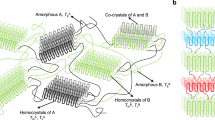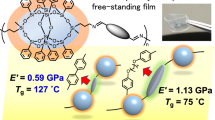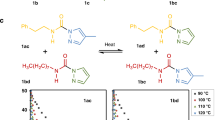Abstract
Supramolecular materials formed via metal-ligand coordination, so-called metallosupramolecular materials, have attracted attention due to their ability to modify a broad range of physical properties depending on the association strength at the coordination bond. Here, we demonstrate the correlation between the glass transition properties and the ligand distance by utilizing amorphous polyesters (denoted as PE-Py) with pendant pyridine ligands arranged homogeneously along the chain. The ligand distance is treated as the pyridine group equivalent molecular weight (MPy) and takes values of 900, 750, 550, and 420. The metal salt ZnCl2 forms coordination bonds with the pyridine ligands, generating a metallosupramolecular network. The fraction of coordinated pyridine is finely tuned by the mole ratio between the pyridine ligand and ZnCl2 ([Zn2+]/[Py]) while adhering to the stoichiometric rule. DSC measurements reveal that the variation in the glass transition temperature (Tg) with increasing [Zn2+]/[Py] is closely correlated with 1/MPy. Temperature-ramp rheological measurements are also performed, revealing that the apparent activation energy (Ea) of segmental motion has a quasi-linear relationship with 1/MPy. Thus, the present study demonstrates that the degree of restriction for segmental motion is very systematically strengthened as the ligand distance decreases, highlighting the importance of ligand distance in physical property control of metallosupramolecular materials.
This is a preview of subscription content, access via your institution
Access options
Subscribe to this journal
Receive 12 print issues and online access
$259.00 per year
only $21.58 per issue
Buy this article
- Purchase on Springer Link
- Instant access to full article PDF
Prices may be subject to local taxes which are calculated during checkout






Similar content being viewed by others
Change history
01 June 2020
An amendment to this paper has been published and can be accessed via a link at the top of the paper.
References
Aida T, Meijer EW, Stupp SI. Functional supramolecular polymers. Science. 2012;335:813–7.
Brunsveld L, Folmer BJB, Meijer EW, Sijbesma RP. Supramolecular polymers. Chem Rev. 2001;101:4071–97.
Cordier P, Tournilhac F, Soulie-Ziakovic C, Leibler L. Self-healing and thermoreversible rubber from supramolecular assembly. Nature. 2008;451:977–80.
Chen YL, Kushner AM, Williams GA, Guan ZB. Multiphase design of autonomic self-healing thermoplastic elastomers. Nat Chem. 2012;4:467–72.
Tamate R, Hashimoto K, Horii T, Hirasawa M, Li X, Shibayama M, et al. Self-healing micellar ion gels based on multiple hydrogen bonding. Adv Mater. 2018;30:1802792.
Hentschel J, Kushner AM, Ziller J, Guan ZB. Self-healing supramolecular block copolymers. Angew Chem Int Ed. 2012;51:10561–5.
Bossion A, Olazabal I, Aguirresarobe RH, Marina S, Martin J, Irusta L, et al. Synthesis of self-healable waterborne isocyanate-free poly(hydroxyurethane)-based supramolecular networks by ionic interactions. Polym Chem. 2019;10:2723–33.
Miwa Y, Taira K, Kurachi J, Udagawa T, Kutsumizu S. A gas-plastic elastomer that quickly self-heals damage with the aid of CO2 gas. Nat Commun. 2019;10:1828.
Li XF, Yang Q, Zhao YJ, Longa SJ, Zheng J. Dual physically crosslinked double network hydrogels with high toughness and self-healing properties. Soft Matter. 2017;13:911–20.
Nakahata M, Takashima Y, Yamaguchi H, Harada A. Redox-responsive self-healing materials formed from host-guest polymers. Nat Commun. 2011;2:511.
Nomimura S, Osaki M, Park J, Ikura R, Takashima Y, Yamaguchi H, et al. Self-healing alkyl acrylate-based supramolecular elastomers cross-linked via host-guest interactions. Macromolecules. 2019;52:2659–68.
Zhang MM, Xu DH, Yan XZ, Chen JZ, Dong SY, Zheng B, et al. Self-healing supramolecular gels formed by crown ether based host-guest interactions. Angew Chem Int Ed. 2012;51:7011–5.
Burnworth M, Tang LM, Kumpfer JR, Duncan AJ, Beyer FL, Fiore GL, et al. Optically healable supramolecular polymers. Nature. 2011;472:334–7.
Harris RD, Auletta JT, Motlagh SAM, Lawless MJ, Perri NM, Saxena S, et al. Chemical and electrochemical manipulation of mechanical properties in stimuli-responsive copper-cross-linked hydrogels. ACS Macro Lett. 2013;2:1095–9.
Hayashi M, Matsushima S, Noro A, Matsushita Y. Mechanical property enhancement of ABA block copolymer-based elastomers by incorporating transient cross-links into soft middle block. Macromolecules. 2015;48:421–31.
Beck JB, Rowan SJ. Multistimuli, multiresponsive metallo-supramolecular polymers. J Am Chem Soc. 2003;125:13922–3.
Whittell GR, Hager MD, Schubert US, Manners I. Functional soft materials from metallopolymers and metallosupramolecular polymers. Nat Mater. 2011;10:176–88.
Miller AK, Li Z, Streletzky KA, Jamieson AM, Rowan SJ. Redox-induced polymerisation/depolymerisation of metallo-supramolecular polymers. Polym Chem. 2012;3:3132–8.
Kumpfer JR, Jin JZ, Rowan SJ. Stimuli-responsive europium-containing metallo-supramolecular polymers. J Mater Chem 2010;20:145–51.
Heinzmann C, Coulibaly S, Roulin A, Fiore GL, Weder C. Light-induced bonding and debonding with supramolecular adhesives. ACS Appl Mater Interfaces. 2014;6:4713–9.
Noro A, Matsushima S, He XD, Hayashi M, Matsushita Y. Thermoreversible supramolecular polymer gels via metal-ligand coordination in an ionic liquid. Macromolecules. 2013;46:8304–10.
Grindy SC, Learsch R, Mozhdehi D, Cheng J, Barrett DG, Guan ZB, et al. Control of hierarchical polymer mechanics with bioinspired metal-coordination dynamics. Nat Mater. 2015;14:1210–6.
Rao YL, Chortos A, Pfattner R, Lissel F, Chiu YC, Feig V, et al. Stretchable self-healing polymeric dielectrics cross-linked through metal-ligand coordination. J Am Chem Soc. 2016;138:6020–7.
McCurdie MP, Belfiore LA. Spectroscopic analysis of transition-metal coordination complexes based on poly(4-vinylpyridine) and dichlorotricarbonylruthenium(II). Polymer 1999;40:2889–902.
Jia XY, Mei JF, Lai JC, Li CH, You XZ. A highly stretchable polymer that can be thermally healed at mild temperature. Macromol Rapid Commun. 2016;37:952–6.
Jackson AC, Beyer FL, Price SC, Rinderspacher BC, Lambeth RH. Role of metal-ligand bond strength and phase separation on the mechanical properties of metallopolymer films. Macromolecules. 2013;46:5416–22.
Brassinne J, Stevens AM, Van Ruymbeke E, Gohy JF, Fustin CA. Hydrogels with dual relaxation and two-step gel-sol transition from heterotelechelic polymers. Macromolecules. 2013;46:9134–43.
Zhuge F, Brassinne J, Fustin CA, van Ruymbeke E, Gohy JF. Synthesis and rheology of bulk metallo-supramolecular polymers from telechelic entangled precursors. Macromolecules. 2017;50:5165–75.
Mozhdehi D, Neal JA, Grindy SC, Cordeau Y, Ayala S, Holten-Andersen N, et al. Tuning dynamic mechanical response in metallopolymer networks through simultaneous control of structural and temporal properties of the networks. Macromolecules. 2016;49:6310–21.
Hayashi M, Shibata K, Kawarazaki I, Takasu A. Simple strategy for dual control of crystallization and thermal property on polyesters by dispersing metal salts via multiple coordination bonds. Macromol Chem Phys. 2018;219:1800127.
Hooda S. Reactivity ratio determination and complete spectral assignment of 4-vinyl pyridine-ethyl acrylate copolymer by NMR spectroscopy. Indian J Chem, Sect A: Inorg, Bioinorg, Phys, Theor Anal Chem. 2002;41:723–9.
Cadova E, Konecny J, Kriz J, Svitakova R, Holler P, Genzer J, et al. ATRP of 2-Vinylpyridine and tert-Butyl Acrylate mixtures giving precursors of polyampholytes. J Polym Sci Pol Chem. 2010;48:735–41.
Moad G, Solomon D. H. The Chemistry of Radical Polymerization. 2nd ed. Elsevier: 2006.
Noro A, Sageshima Y, Arai S, Matsushita Y. Preparation and morphology control of block copolymer/metal salt hybrids via solvent-casting by using a solvent with coordination ability. Macromolecules. 2010;43:5358–64.
Sageshima Y, Noro A, Matsushita Y. Structural isomer effects on the morphology of block copolymer/metal salts hybrids. J Polym Sci Pt B-Polym Phys. 2014;52:377–86.
Hayashi M, Yano R, Takasu A. Synthesis of amorphous low Tg polyesters with multiple COOH side groups and their utilization for elastomeric vitrimers based on post-polymerization cross-linking. Polym Chem. 2019;10:2047–56.
Hayashi M, Sugimoto K, Takasu A. Preparation of all polyester-based semi-ipn elastomers containing self-associative or non-associative guest chains via post-blending cross-linking. Macromol Mater Eng. 2019;304:1900147.
Tazuke S, Okamura S. Effects of metal salts on polymerization. Part III. Radical polymerizabilities and infrared spectra of vinylpyridines complexed with zinc and cadmium salts. J Polym Sci, A-1, Polym Chem. 1967;5:1083–99.
Kuo SW, Wu CH, Chang FC. Thermal properties, interactions, morphologies, and conductivity behavior in blends of poly(vinylpyridine)s and zinc perchlorate. Macromolecules. 2004;37:192–200.
Fox TG, Loshaek S. Influence of molecular weight and degree of crosslinking on the specific volume and glass temperature of polymers. J Polym Sci 1955;15:371–90.
Pire M, Norvez S, Iliopoulos I, Le Rossignol B, Leibler L. Epoxidized natural rubber/dicarboxylic acid self-vulcanized blends. Polymer. 2010;51:5903–9.
Kim JY, Hong SU, Won J, Kang YS. Molecular model and analysis of glass transition temperatures for polymer-diluent-salt systems. Macromolecules. 2000;33:3161–5.
Kim JH, Min BR, Won J, Kang YS. Analysis of the glass transition behavior of polymer-salt complexes: an extended configurational entropy model.J Phys Chem B. 2003;107:5901–5.
Lu H, Lovell LG, Bowman CN. Exploiting the heterogeneity of cross-linked photopolymers to create High-Tg polymers from polymerizations performed at ambient conditions. Macromolecules. 2001;34:8021–5.
Jangizehi A, Ahmadi M, Seiffert S. Dynamics of supramolecular associative polymer networks at the interplay of chain entanglement, transient chain association, and chain-sticker clustering. J Polym Sci Pt B-Polym Phys. 2019;57:1209–23.
Huang HM, Yang S. J. Studying the miscibility and thermal behavior of polybenzoxazine/poly(epsilon-caprolactone) blends using DSC, DMA, and solid state C-13 NMR spectroscopy. Polymer. 2005;46:8068–78.
Szefer E, Stafin K, Leszczynska A, Zajac P, Hebda E, Raftopoulos KN, et al. Morphology, dynamics, and order development in a thermoplastic polyurethane with melt blended POSS. J Polym Sci Pt B-Polym Phys. 2019;57:1133–42.
Adam G, Gibbs JH. On the temperature dependence of cooperative relaxation properties in glass forming liquids. J Chem Phys. 1965;43:139–46.
Bennemann C, Donati C, Baschnagel J, Glotzer SC. Growing range of correlated motion in a polymer melt on cooling towards the glass transition. Nature. 1999;399:246–9.
Russell EV, Israeloff NE. Direct observation of molecular cooperativity near the glass transition. Nature. 2000;408:695–8.
Acknowledgements
The authors thank Mrs. A. Yamagishi at Anton Paar for her assistance with the rheological measurements. This work was supported by a grant from the Ogasawara Foundation for the Promotion of Science & Engineering. The SAXS measurements were conducted at BL8S3 of the Aichi Synchrotron Radiation Center, Aichi Science & Technology Foundation, Aichi, Japan (Proposal No. 201903070).
Author information
Authors and Affiliations
Corresponding author
Ethics declarations
Conflict of interest
The authors declare that they have no conflict of interest.
Additional information
Publisher’s note Springer Nature remains neutral with regard to jurisdictional claims in published maps and institutional affiliations.
Supplementary information
41428_2020_304_MOESM1_ESM.docx
Supplementary Information: Glass transition analysis of model metallosupramolecular polyesters bearing pendant pyridine ligands with controlled ligand–ligand distance
Rights and permissions
About this article
Cite this article
Hayashi, M., Obara, H., Shibata, K. et al. Glass transition analysis of model metallosupramolecular polyesters bearing pendant pyridine ligands with a controlled ligand–ligand distance. Polym J 52, 505–514 (2020). https://doi.org/10.1038/s41428-020-0304-2
Received:
Revised:
Accepted:
Published:
Issue Date:
DOI: https://doi.org/10.1038/s41428-020-0304-2



